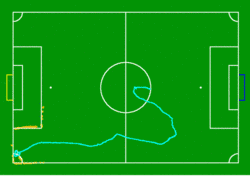Brainstormers Tribots self localization
An autonomous robot per se does not know its position and orientation on a soccer field. Hence, the robot must use its sensors to get an idea of its own pose. In the case of many soccer robots, the robots are equipped with an omnidirectional camera system that allows the robot to make 360 degree pictures of its environment. From these images, the robot must be able to localize itself. The idea of self localization is to find the best matching between the images that are made by the camera and the robot's knowledge of the field. E.g. the robot knows how large the field is, where the goals are located on the field and where the white lines are painted on the ground. By comparing the position of these objects in the omnidirectional image with the known position of the images, the robot is able to estimate its own position and orientation on the field.
The Tribots' Approach
 The Brainstormers Tribots primarily use the white lines on the field for localization since they exist in all areas of the soccer field and they can be recognized easily in the camera images. For all other landmarks on the field like the two goals and the corner poles the risk of confusing landmark with spectators standing next to the soccer field is too large to achieve a robust self localization method.
The Brainstormers Tribots primarily use the white lines on the field for localization since they exist in all areas of the soccer field and they can be recognized easily in the camera images. For all other landmarks on the field like the two goals and the corner poles the risk of confusing landmark with spectators standing next to the soccer field is too large to achieve a robust self localization method.
The first step is to find the lines in the camera image. This is done in the vision subsystem. As result, we get an incomplete list of points in robocentric coordinates which are likely to belong to the field markings. Onto these points we apply a matching algorithm that finds the robot pose at which the observed lines match optimally with our knowledge of the lines. Beside the position of the robot, this approach also yields measures of reliability that we can use in a temporal integration process to get smooth trajectories of the robot motion over time.
The self-localization approach of the Tribots is primarily an approach to track the robot position from a given inital robot pose but it can be extended to find the initial position as well. This was successfully proved in a Technical Challenge at the RoboCup 2007 World Cup. The approach was invented in 2004 and applied for the first time in 2005. Since then, it has been used in all tournaments with only little adaptations and extensions. Although it was developped for smaller field sizes of 8×12 meter it also worked on the larger fields of 12×18 meter size.


